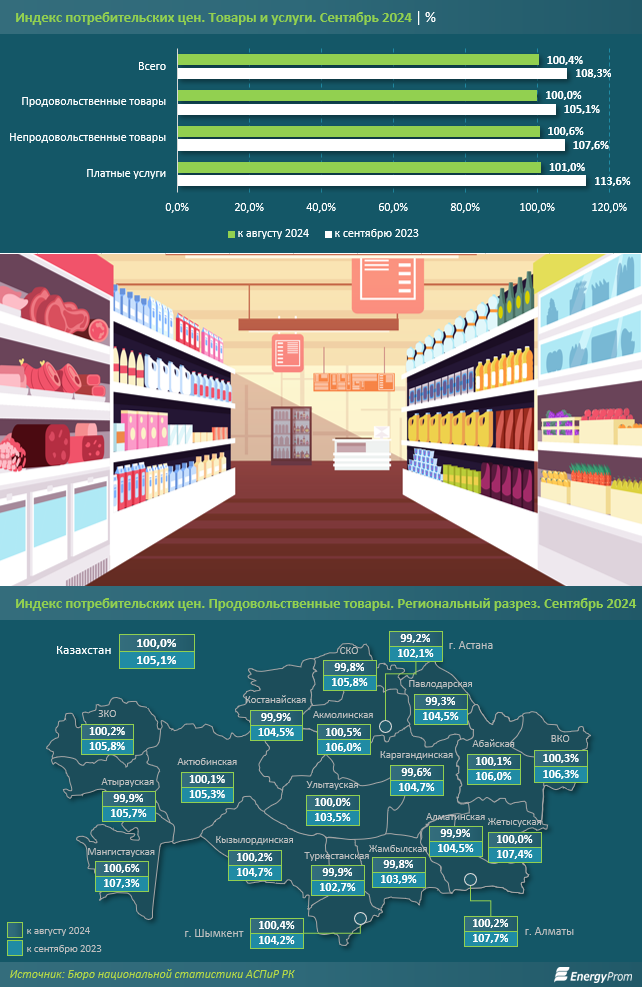What do Kazakhs think about food security? According to a survey conducted by the National Statistics Bureau of the Agency for Strategic Planning and Reforms of Kazakhstan, 4.4% of respondents expressed concern that they would not have enough food due to a lack of money or other resources. 90.4% indicated they were not worried about this issue, 2.8% found it difficult to answer, and another 2.4% refused to respond, as reported by inbusiness.kz referencing Energyprom.
2.4% of those surveyed could not afford healthy and nutritious food due to financial constraints, while another 2.4% declined to answer the question regarding such possibilities.
Over the past year, 3.2% of respondents have only been able to consume a limited number of products due to a lack of money, and 2.5% of respondents did not wish to answer questions about dietary issues caused by poverty.
0.9% of respondents reported skipping meals due to financial difficulties, while 1.2% ate less than they should have due to financial hardships. Additionally, 1.1% of respondents found themselves in situations where food was running out in the family, 0.7% experienced hunger without the ability to alleviate it, and 0.6% went hungry for an entire day. More than 2% of respondents refused to answer these questions. Details are in the table.

At the same time, food inflation in Kazakhstan has finally slowed down after the monstrous figures of previous years. In September of this year, the overall inflation rate was 0.4% month-on-month and 8.3% year-on-year, with food prices remaining stable over the month and increasing by 5.1% over the year.
For comparison, prices for paid services rose by 1% month-on-month and by 13.6% year-on-year, while non-food products increased by 0.6% month-on-month and by 7.6% year-on-year.
Regionally, food prices increased in 9 out of 20 regions of the country on a month-on-month basis. The price increase ranged from 0.1% to 0.6%. The highest increase was noted in the Mangistau region, while the lowest was in the Abai and Aktobe regions. In two regions, the Zhetysu and Ulytau regions, prices remained at the level of the previous month. A decrease in food prices (from -0.1% to -0.8%) was observed in the remaining 9 regions.
In the annual dynamics, food prices saw the most significant increases in Almaty (by 7.7%), as well as in the Zhetysu (by 7.4%) and Mangistau (by 7.3%) regions. The smallest annual increase was recorded in Astana (by 2.1%), as well as in the Turkestan (by 2.7%) and Ulytau (by 3.5%) regions.

In terms of product categories, eggs (up by 6%), oils and fats (up by 1.8%), and alcoholic beverages (up by 0.7%) saw the most notable price increases over the month. Price increases were also noted in categories such as non-alcoholic beverages (up by 0.6%), dairy products (up by 0.4%), fish and seafood (up by 0.3%), bakery products (up by 0.2%), and meat and meat products (up by 0.2%). Sugar prices remained unchanged, while fruits and vegetables became cheaper by 3.6%.
In annual dynamics, the most significant price increases were recorded for eggs (up by 11.8%), alcoholic beverages (up by 9.5%), and non-alcoholic beverages (up by 8%). Fish and seafood rose by 7.3%, sugar, jam, honey, and chocolate by 6.9%, bakery products by 5.5%, dairy products by 5.3%, fruits and vegetables by 3.9%, and meat by 3.6%. Meanwhile, oils and fats experienced a price drop of 1.1% in annual dynamics.
